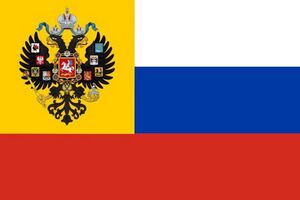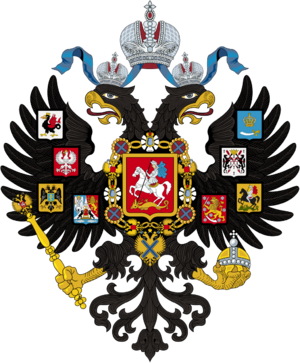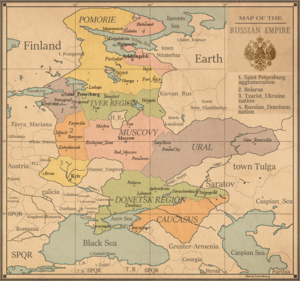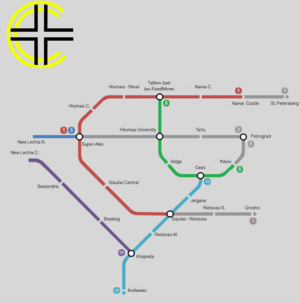Nova:Russia: Difference between revisions
>Smgfour2 |
>Smgfour2 |
(No difference)
| |
Revision as of 01:39, 3 November 2020
| |||||||||||||||||||||||||||||||||||
The Russian Empire (Russian: Российская империя) is the largest state in Eastern Europe, which was formed during the unification of Russia and Tzarist Russia.
Member country of the GRE.
The Russian Empire has two capitals: Moscow and Saint Petersburg. The largest cities of the Russian Empire are Minsk, Petrograd, New_Bonsville, Velsk, Saint Petersburg, and Moscow.
History
October 2020
On October 26, 2020, Tsar of Russia ItzNotNeon, Prime Minister of Russia Limkid and Tsar of Tsarist Russia Kraznov, head of SPQR CorruptedGreed signed an agreement under which Russia and Tsarist Russia were United into a single state — the Russian Empire. The signing of this Treaty put an end to the long-standing feud between both sides and gave an opportunity to look at Eastern Europe in a different way: a huge giant with two capitals appeared on the map: Moscow and St. Petersburg.
On October 27, the High Council of the Russian Empire, Elgik, proposed to the Senate for approval a large-scale project to reform the structure of public administration. 93.75% of senators supported the reform, 6.25% voted against it. the Reforms abolished the post of the High Council and created a Cabinet of Ministers, the post of Prime Minister and Governor, and a regional Duma was established in each region. Also, an office was created, consisting of counts who oversee the power in the districts.
From 28 to 30 October, the election of the Prime Minister was held, in which the high Council Elgik won with 90.91% of the total turnout.
Government
The system of government of the Russian Empire consists of sufficiently developed branches of government. This is an original system that combines autocracy and democracy.
Emperor
There are two emperors in Russia: Toporkov and ItzNotNeon. This decision was made during the unification of Nations. They will also have two successors. In the case of disputed decisions, when the tsars cannot reach a common result, the Prime Minister gets the third vote. Emperors cannot be deprived of their throne and deposed, as this is illegal.
Prime Minister
The Prime Minister of the Russian Empire is elected in national elections every three months. At the moment, the position of Prime Minister of Russia is held by Elgik. The Prime Minister directs the Executive and legislative branches of government. All Ministers, princes, senators, governors, and regional Dumas are subordinate to him. He has the right to pass laws with the approval of the Senate, dismiss governors, change the composition of regions, command troops, control foreign policy, approve economic plans, and much more. Can be dismissed by the tsars.
Government
The Cabinet of Ministers of the Russian Empire consists of Ministers who are appointed by the Prime Minister with the approval of the Senate. Each Minister is responsible for their area of activity and can be dismissed by the Prime Minister or the Tsar.
Composition of the Cabinet of Ministers of the Russian Empire (11.2020)
- Prime Minister — Elgik
- Defense Minister — alsjad
- Trade Minister — Petr_The_First
- Infrastructure Minister — PycckueBnepeg
Senate
The Senate of the Russian Empire consists of governors, Ministers, and the Prime Minister of Russia. It passes various bills, approves the composition of the Cabinet of Ministers, makes decisions on mobilization, the introduction of a state of emergency in the country.
Duke
Duke are appointed by the king and exercise control functions: they take two regions under their authority and monitor the work of governors and regional Dumas, the course of elections, and the implementation of legislation. They have the right to take the initiative to dismiss the Governor or initiate a control case against any person. They have immunity, as well as Emperors and the Prime Minister.
List of governors of the Russian Empire (11.2020)
Governor
The Governor is the head of the region. Gubernatorial elections are held every two months. Any resident of the region can become the head of the region. In the capital of each region there is an administration building, which should be the office of the Governor. The Governor heads the regional Duma, manages all Affairs in the region, is the link between the population, mayors and the Cabinet of Ministers.
Regional Duma
The regional Duma consists of city mayors and is headed by the regional Governor. It makes decisions of local significance that do not concern the Senate.
Transport
Russia is a fairly developed country in the field of transport. The state has a metro system, aboveground ice trails, trails, and cobblestone roads. The construction of transport branches in Russian Empire is handled by the Ministry of construction and transport.
Subway
CTM
The first station of the Russian metro was the station in Saint Petersburg. It became the Terminus of the bright red branch of the CTM metro. The construction of this station made it possible to connect Saint Petersburg with the cities of Terra_mariana, Finland, Poland and many others. Of course, at that time it was a real transport progress for St. Petersburg: the lack of full-fledged roads, and even more so, ice trails, created problems with establishing relations with Russia's allies. The station in Saint Petersburg still exists, but it is not as popular as before. In addition, there is an unfinished extension of the metro line to Pavlodar.
Metro «Yenisei»
After Francon became Prime Minister Of Russia, the solution of transport links between Russian cities became one of the main tasks that the government faced. Francon made it clear that the cities of Russia are practically not connected by an ice route, except for some aboveground trails and trails. It was necessary to create an underground network of ice trails independent of external factors that would connect Russian cities.
Together with Ivan, who took up the post of Minister of construction and transport in the new government, Francon developed a plan for the construction of a single Russian metro. The first cities that were connected by the highway were Saint Petersburg and Pavlodar. The connection of these cities was quite understandable: Pavlodar was one of the largest cities in Russia, which is why often Pavlodar residents bought mobs or other items that can be transported exclusively on the highway in St. Petersburg. However, the development of the ice route did not stop: in the next two weeks, routes were laid to Volzhsk, Yaroslavl, Moscow and Novgorod. Over the next two months, Ladoga, Winterhur and Velsk were also added to the ice route.
It is also worth noting that this ice route is connected to the Finnish ice route. Thus, you can get to some cities in Finland from Russian cities. The agreement on cooperation in the transport industry between Russia and Finland was signed during the meeting of the governments of Russian Empire and Finland in St. Petersburg in June 2020.
Stations have been built in each city where the ice route is laid. Some of them can be blocked in case of danger, which can help in the complete isolation of the city. There are also shops at the stations that sell boats and other items. In the future, it is planned to connect Minsk, Volozhin, Vologda, Ivangorod, Tarkov and Rovaniemi to the ice route.
Aboveground ice road
On the territory of Russia, there are three ice tracks that are repaired monthly and their condition is monitored. Ice trails mainly connect Saint Petersburg with remote cities: Winterhur, Vologda and empty territories. Also, these routes lead to foreign countries. The tracks are located at different heights, which creates some discomfort in their use, but due to this, there is no full-fledged traffic, which allows you to avoid traffic jams.
Roads and trails
On the territory of Russia there are a large number of trails that are not controlled by Russia and several cobblestone roads. The most famous is the water path that connects the cities in Donetsk to Moscow for transit to the ice path.
Economy
Farming
The agricultural sector in the Russian Empire mainly consists of farms, which are located in almost every city in the country. Russians actively grow almost all types of plants: wheat, potatoes, carrots, bamboo, sugar cane, watermelons and pumpkins. These products are not only food, but also actively used in trade: a large number of stores are filled with food. Thanks to this, there is no hunger in Russia. Fields in Russia are either on the surface or underground: under St. Petersburg, Ladoga, Petrograd and other cities there are huge reserves of wheat, carrots, potatoes and watermelons. In Volzhsk, Pavlodar, Vologda and many other cities, fields are built to match the landscape and seem to be natural structures.
Animal husbandry in the Russian Empire is no less developed than the cultivation of crops. Mostly, in large cities there are chickens, cows, and sheep. Sometimes there are pigs in cities.
Industry
Industry in the Russian Empire is not as well developed as agriculture. The largest enterprises are associated with the production of building materials and food. They are concentrated in Saint Petersburg and Petrograd. There are also factories near Moscow, Pavlodar, Volgograd and other cities. They are smaller in scale.
Trade
The largest store in Russia is Euro Polis, located in Petrograd. However, trade is also developed in other cities: in Pavlodar, Volzhsk, Ponsacco, Moscow, Kiev, Kalgalaksha there are small shops. The Ministry of trade plans to build a Large Gostiny Dvor In St. Petersburg and GUM in Moscow in the coming months to expand the budget and develop trade in General.
Army
The army of the Russian Empire is one of the largest in its composition and has a large mobilization resource: about 35 people. For greater convenience of the army's leadership, it is divided into two regiments: one consists of English-speaking players, the other of Russian-speaking players. The Russian army is subordinate to the Tsars and the Prime Minister. The army is led by the Minister of defense.
Towns
| City | Mayor | Population | Region |
|---|---|---|---|
| Saint Petersburg | ItzNotNeon | 15 | Petersburg district |
| Moscow | Sverker_ | 9 | Muscovy |
| Minsk | cyelio | 41 | Belarus |
| Kyiv | Domovyk | 8 | Tzarist Ukraine |
| Arkhangelsk | Probka_Dead | 5 | North Region |
| Rivne | Bambia | 1 | Tzarist Ukraine |
| Ladoga | UraDude | 2 | Pomorie |
| Pavlodar | mr4xolotl | 1 | Pomorie |
| Volzhsk | SPECTREiscoming | 2 | Pomorie |
| Velsk | Ervest | 12 | Pomorie |
| Победа | Probka_C | 3 | North Region |
| Mourmansk | Hugoku99 | 1 | Pomorie |
| Donbass | alsjad | 5 | Donetsk region |
| Novocherkassk | Mixse | 4 | Donetsk region |
| Red_Moscow | Zhengjc | 2 | Muscovy |
| Kalgalaksha | NZXYT | 3 | Pomorie |
| Barysaw | MackRemi19000 | 1 | Belarus |
| Kingisepp | _Ne_Neon_ | 1 | Petersburg district |
| Yaroslavl | _AgentBlackout_ | 1 | Tver region |
| Caucasia | TheFrostys | 1 | Caucasus |
| Viterga | MihaxInc | 3 | Pomorie |
| Poltava | kirillwey | 2 | Donetsk region |
| Petrograd | Petr_The_First | 29 | Petersburg district |
| Sevastopol | Hannibal_Barqa | 2 | Donetsk region |
| Победа | Probka_C | 3 | North Region |
| Tvet | FlashWarrior5 | 1 | Muscovy |
| Berdyansk | Berdyansk | 2 | Donetsk region |
| Ponsacco | m51vortice | 1 | Muscovy |
| Volgograd | Bladen2k | 1 | Donetsk region |
| Aphrodisias | xtapodi_ | 5 | Donetsk region |
| New_Bonsville | Funny_Meme_47 | 15 | Ural |
| LeroTown | Lerokes | 1 | Ural |
| Tver | _Leafty_ | 1 | Tver region |
| Kahnikostok | ConnorTheVGFan78 | 1 | Belarus |
| Luhansk | InfernoTower | 4 | Donetsk region |
| Novgorod | _CorvusGlaive_ | 2 | Petersburg district |
| Exclusion_Zone | AnatoliSuperSlav | 3 | Muscovy |
| PotatoCity | gamer_64_ | 1 | Ural |
| Vologda | Savernik | 1 | Tver region |
| Fort_Velsk | EBorg2505 | 1 | Pomorie |
| Moskva | Jekol | 1 | Muscovy |



